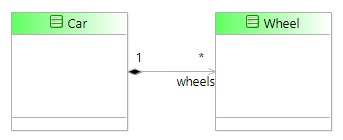Relationships
Relationships are used to show the relationships between objects and consist of associations and composition.
Note: The terms described in this section are identical in meaning to the same terms described in UML.
Relationships in the business object model can be grouped into two types:
- Associations, and
Composition. Composition is a more specific type of the general relationship type Association.
These types can be further classified with regards to:
All relationships can have various labels when they are created in a business object model. A label name for the relationship is not displayed by default but can be added. They also display the names of the Classes and the multiplicity allowed for the Classes.
This is shown below:
Copyright © 2021. Cloud Software Group, Inc. All Rights Reserved.

